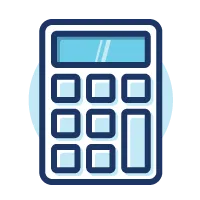What We'll Cover
- Steps to figure out how much you need to save for your first home
- The costs associated with buying a home
- Tips to help you save money for a home
Do you dream about buying your first home? Down payments, mortgage loans, property taxes – all the home-buying costs can be overwhelming. Whether you hope to buy a home soon or a few years down the road, saving money now will help you be ready when your dream home becomes available on the market. Let’s look at how much you need to save for your first home as well as some strategies to get you there.
How Much Do You Need to Save for Your First Home? Here’s What You Need to Know
Before we get into the tips for saving for your first home, let’s look at your goals, timeline and all the home-buying costs you need to be aware of.
1. Get pre-qualified and determine what you can afford.
When you apply for a mortgage, you will have to qualify to be able to borrow. Most lenders consider your Debt-to-Income (DTI) ratio, which compares your other financial responsibilities like car payments, personal loans, college loans, and other debts against your income. They don't want these expenses—plus your housing costs—to be any more than 50% of your monthly income. Depending on the scenario and institution, DTI requirements range from 36-50%. In short, a lender wants to be sure you'll be able to pay your mortgage before they let you borrow.
Often though, you’ll be approved for a larger mortgage than you may realistically be able to handle. A good rule of thumb is to keep your total mortgage payment at 25% or below your take-home pay. This total mortgage payment refers to the total of the principal, interest, taxes and insurance payments.
Use a mortgage calculator to determine what type of home is in your budget.
2. Understand the Cost of Buying
Buying a home comes with more than the listing price. When you’re saving for your first home, think about the following costs:
- Down payment: This is the cash you pay upfront for your home. The down payment is usually between 3 – 20% of the sale price. For example, a conventional loan will allow as low as 3% down. Keep in mind though, when your down payment is less than 20% of the home sale price, you’ll be required to pay a monthly mortgage insurance premium for private mortgage insurance or PMI. This will add to your monthly payment, thus decreasing the amount of home you may be able to afford. Keep in mind that the more you put down, the smaller your mortgage payments will be.
- Mortgage: What a mortgage costs depends on three main factors: the principal, or amount you borrow, the interest you pay for borrowing the money, and the term, or length of time the mortgage lasts.
- Property taxes, closing costs, and other hidden costs: One of the biggest mistakes first-time homeowners make is spending more than they can afford by overlooking the “true” cost of homeownership. You’ll need to account for between 2 and 5 percent of the purchase price of the home in closing costs, such as fees for appraisal, escrow, and home inspection, among others. With your monthly payments, you’ll also be responsible for paying property taxes.
3. Define your goals and timeline.
Now that you have an idea of how much house you can afford and all the costs associated with buying a house, think about the logistics of what you want in your home. What area of town do you want to live in? What features do you need? How many bedrooms and bathrooms? Is a swimming pool a must or can you live without it?
Make your list of must-haves and determine how they factor into the price of the home you want to buy. Can you afford the home you’re looking for? Do you need to adjust your expectations or consider another location for better affordability?
Once you have these costs figured out, look at your timeline. How long will it take you to save for your first home? Set a realistic date, then use the steps below to start saving.
Tips for Saving for Your First Home
Now that you have a clear picture of your home-buying financial journey, it’s time to get saving. Here are a few ideas to help you get ready to buy your first home:
Propel your savings.
Earn higher dividends on lower balances and reach your goals faster with Propel Savings.
Create a new budget
First, create a budget that allows you to save a portion of your income each month toward your dream home fund. Start by tracking your income and expenses to get a good understanding of your financial situation. Then, determine where you can cut costs to increase your savings. Can you cancel some subscriptions or streaming services for a while? Maybe you can find cheaper alternatives for your Internet or cell phone plans.
Keep down payment savings in a separate account
Keep a separate savings account just for your home savings so you know how much is in there at all times. To really maximize your savings, look for a high-yield savings account that offers higher interest rates to help you grow your earnings and reach that down payment amount faster. For the short- to mid-term saver, there are benefits to using a high-yield savings account, money market account, or Share Certificate.
Automate your savings.
Create a monthly automated transfer from your checking account to your savings account, so when your paycheck is deposited it automatically does the work for you. Set it and forget it!
Key Takeaways
- Start your home savings by getting prequalified for a mortgage loan and determining how much you can afford.
- Remember to account for between 2 and 5 percent of the purchase price of the home in closing costs.
- Create a budget to determine how much you can set aside each month for your home savings.
- Keep your down payment savings in a separate account, preferably a high-yield savings account that allows you to grow your earnings faster.
- Automate your savings so you don’t have to think about it.
Start Saving for Your Dream Home Today
Ready to start saving for your dream home? Open a OneAZ savings account, set up your automated transfer, and start contributing to your down payment. A home should never be something you settle for; start saving a little today so you can buy the home you really want.
APR = Annual Percentage Rate













